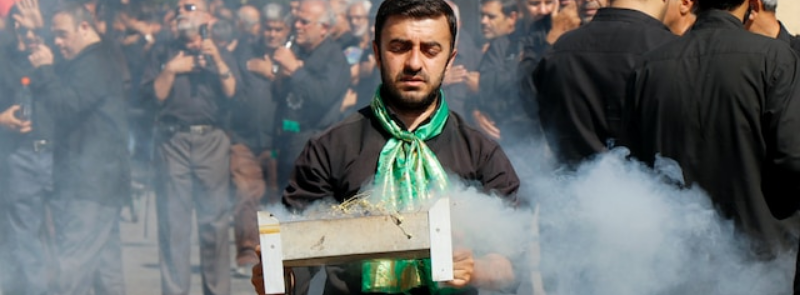
When It Occurs
Annually First Month of Islamic Calendar
Timeline
Days Passed (484)
# Hashtags
#Muharram #BattleOfKarbala
Muharram marks the inception of the Islamic calendar as the first month and the Islamic New Year. Designated as one of the four sacred months by Allah, it holds a sanctified status. The name "Muharram" directly translates to "forbidden," and it is a month where warfare is strictly prohibited.
For the Muslim community, Muharram is a time of profound sorrow, especially as they mourn the passing of Hazrat Imam Hussain, the grandson of Prophet Muhammad. The tenth day of Muharram, known as Ashura, solemnly commemorates the martyrdom of Hussein Ibn Ali during the Battle of Karbala.
Historical and Religious Significance
- Muharram is the second holiest month in Islam after Ramadan. The month’s importance lies in the martyrdom of Imam Hussain (son of Imam Ali and grandson of Prophet Muhammad), who along with his family and followers was killed in the Battle of Karbala.
- Imam Hussain’s death represents the ultimate sacrifice for justice and righteousness. He and his followers refused to submit to the tyrannical rule of Yazid I, the Umayyad Caliph. His stand against oppression and his refusal to pledge allegiance to Yazid became a symbol of the fight against injustice.
- For Shia Muslims, the 10th day of Muharram, called Ashura, is particularly significant as it marks the day of Imam Hussain's martyrdom. The day is observed with intense mourning and remembrance.
- Sunni Muslims also revere Muharram and observe Ashura, but their focus is different, with some fasting on the day as a means of seeking forgiveness and blessings from God. According to Sunni traditions, Ashura is the day when Prophet Moses (Musa) and the Israelites were saved from Pharaoh’s tyranny.
Muharram Observances in India
India has a large Muslim population, and Muharram is observed across the country with great reverence. The observances are most pronounced among the Shia Muslim communities, but Sunni Muslims also mark the month in various ways. The rituals of Muharram in India vary depending on the region and the sect of Islam.
Shia Observances
-
Majlis: Shia Muslims hold mourning gatherings known as Majlis, where religious scholars recount the story of the Battle of Karbala, Imam Hussain’s sacrifice, and the struggles faced by his family. The recitations of the battle's events are emotional and filled with expressions of grief. The Marsiya (elegy) and Noha (mourning poetry) are recited, evoking sorrow and remembrance.
-
Matam: One of the most visible acts of mourning is Matam, where mourners engage in chest-beating or self-flagellation as an expression of grief over the martyrdom of Imam Hussain. The act symbolizes solidarity with the suffering of Hussain and his family.
-
Processions: The most significant part of Muharram observance is the grand processions, which take place on the 10th day, Ashura. Taziyas (replicas of the tomb of Imam Hussain) are carried through the streets, and mourners walk alongside the Taziyas, chanting "Ya Hussain" and performing Matam. Cities like Lucknow, Hyderabad, and Kolkata witness some of the largest and most elaborate processions.
-
Alam: In Shia tradition, Alams (banners symbolizing the flag of Imam Hussain) are carried in the processions. These banners are often highly decorated and are treated with great respect. Devotees may touch or kiss the Alams as a mark of reverence.
-
Ziyarat: In some areas, people build temporary Imambaras (structures resembling the shrine of Hussain) where Ziyarat (visiting the shrines) is performed. Inside, the history of Karbala is depicted, and mourners visit to pay their respects.
-
No Food or Water: Many Shia Muslims refrain from eating or drinking until the evening of Ashura to remember the thirst and hunger suffered by Imam Hussain and his followers in the desert of Karbala.
Sunni Observances
- Fasting: For Sunni Muslims, the 9th and 10th days of Muharram are observed with fasting. Fasting on Ashura is a Sunnah (recommended practice) of the Prophet Muhammad, and it is believed that fasting on this day expiates sins of the previous year.
- Prayers and Reflection: Sunni Muslims focus on prayer, reflection, and charitable acts during Muharram. While they do not engage in the same mourning practices as Shia Muslims, they honor the historical significance of the day.
Regional Celebrations in India
The observance of Muharram varies from region to region, with some cities hosting particularly large and significant processions.
-
Lucknow (Uttar Pradesh): Lucknow, a major center for Shia Muslims in India, is known for its grand Muharram processions. The city has a long history of Muharram observances, with both Shia and Sunni Muslims participating in the remembrance of Imam Hussain. The Bada Imambara and Chhota Imambara are the focal points of the observances, with processions carrying Alams, Zuljanah (representing the horse of Imam Hussain), and Taziyas.
-
Hyderabad (Telangana): Hyderabad has one of the largest Muharram processions in India, with hundreds of thousands of people participating. The city's old quarters see the streets filled with mourners, performing Matam and carrying Taziyas. The Bibi Ka Alam procession is particularly famous and attracts mourners from across the region.
-
Kolkata (West Bengal): Kolkata’s Muharram processions are notable for their diversity, with both Shia and Sunni communities participating. The Taziya processions in the city are elaborate, and the devotion of the mourners is visible in the large crowds that gather on the streets.
-
Delhi: In the capital city, Muharram is observed with processions starting from areas like Daryaganj and Chandni Chowk. The Karbala at Jor Bagh is an important site where the final rituals of the Taziyas are performed.
Taziya Tradition
A significant feature of Muharram observances in India is the creation of Taziyas, which are elaborate, colorful structures made from paper, bamboo, and other materials. These Taziyas represent the tomb of Imam Hussain and are carried in the processions before being buried or immersed in water at the end of Ashura. The making of Taziyas is considered a sacred and artistic expression of devotion.
Impact on Indian Society
Muharram in India transcends religious boundaries to some extent, with people from other communities often joining the processions out of respect for the historical and spiritual significance of the event. In cities like Lucknow, Hindus sometimes participate in the processions, and artisans from different communities contribute to the construction of the Taziyas.
Ashura in India
The 10th day of Muharram, Ashura, is marked by the climax of mourning rituals. It is a public holiday in several states, and processions are organized in many cities. Security is often heightened during this period, as large gatherings can become highly emotional.
-
Mourning Continues: For Shia Muslims, the mourning continues for the entire month of Muharram, with different events and gatherings commemorating the sacrifices of the family of Imam Hussain.
-
Historical Impact: The message of Ashura has had a profound impact on the Indian subcontinent, particularly as it resonates with themes of resistance against tyranny, the fight for justice, and self-sacrifice. These themes have influenced religious thought, art, and literature in India.
Conclusion
Muharram in India is a deeply spiritual and emotional observance that honors the sacrifices of Imam Hussain and his followers. It brings together different Muslim communities in reflection, mourning, and reverence. The cultural expressions seen during Muharram, such as the construction of Taziyas and the performance of Matam, are unique to the Indian subcontinent and demonstrate the deep devotion of Indian Muslims to the message of Karbala.


